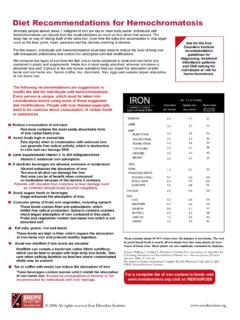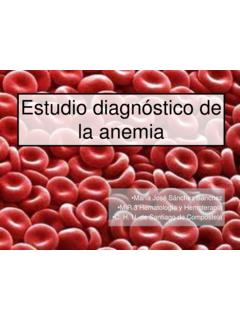Transcription of How do I know if I am anemic? Some tests that your doctor ...
1 DeficiencyAnemiaSideroblasticAnemiaThala ssemiaPorphyriaCutanea TardaAnemia of ChronicDisease (ACD)African siderosisVitamin B12 Deficiency(pernicious anemia )SerumFerritinTransferrinIron SaturationPercentageTotal IronBinding Capacity(TIBC)HemoglobinRed Blood Cell Size Red Blood Cell ColorMCVT ransferrinSerumTransferrinReceptorNORMAL TO LOWNORMALTO LOWNORMALTO HIGHNORMALTO HIGHHIGHHIGHNORMALNORMALNORMALNORMALNORM O-CHROMICNORMO-CHROMICNORMO toHYPO-CHROMICNORMO-CHROMICHYPOCHROMICHY POCHROMICHYPOCHROMICMICROCYTICMACROCYTIC MICROCYTICNORMOCYTICNORMOCYTICNORMO toMICROCYTICNORMOCYTICNORMALNORMALS lightlyDecreasedNORMALNORMO-CHROMICNORMA LOR NORMALOR NORMALOR NORMALOR NORMALOR NORMALOR NORMAL ironpanelI R O N P A N E L T E S T S Microcytic AcquiredCongenitalCongenital basostippling* Normal or Acquired Dimorphic**How do I know if I am anemic ?
2 Adult MalesNormal Females Adolescents, Juveniles, Infants & Newbornsof normal height and weight for their age and genderhemoglobinAge 6-18 years 1-6 years 6 mos-1year 2-6 mos 0-2 weeks To determine if a person is anemic, a physician canmeasure hemoglobin. Persons with a below normal hemoglobin are anemic. IMPORTANT: if you are found to be anemic; ask why? anemia is a symptom. Before treatment begins, it is important to know what is causing the anemia . In some cases taking iron pills to correctthe anemia could be dangerous. There are more than a dozen conditions that can result in anemia ; here are some of the most common:Chronic blood loss (heavy period or disease)Inadequate heme iron (the type of iron in meat) in the diet Nutritional deficiencies such as vitamin C, B12, B6 or folateProblems of absorption such as: not enough stomach acid, lack of intrinsic factor (hormone needed to absorb vitamin B12) Red blood cell production problems (heme synthesis)Red blood cell destruction problems (hemolysis) Chronic disease, such as: hypothyroidism, renal disease, arthritis, diabetes, Crohn's, liver disease, or cancer Alcohol abuseIncreased demand for iron.
3 Growth spurts, acute blood loss Medications (especially those containing aspirin)Excess iron accumulation in the bone marrowComparing blood test results for different types of iron tests that your doctor might do to determine the cause of anemia : Complete Blood Count with differential: which includesHemoglobin, red blood cell count, platelets, white cell countand red blood cell indices, which provides the shape, size and color of blood cells and how anemia is classified. Macrocytic cells are large, microcytic are small; hypochromic are pale, hyperchromic are dark; sickle, spherical, oval, elliptical, stippled, spur, and teardrop etc., describe some abnormal shapes or appearance of a red blood Count: helps to determine the bone marrow response to the anemiaCoomb's direct: helps to determine autoimmune hemolytic anemiaHaptoglobin: helps to determine if hemolysis (early destruction of red blood cells) is taking placeSerum ferritin: to determine "iron stores" or hemosiderosisSerum Transferrin Receptor: to differentiate between anemia of chronic disease and iron deficiency or iron overload What type of physician treats anemia ?
4 All physicians can treat anemia once the underlying cause isdetermined. If the cause is complicated, then a hematologist orgastroenterologist might be consulted. A hematologist specializesin blood cell disorders that result in anemia ; whereas a gastro-enterologist specializes in digestive and nutritional disorders that lead to anemia . Serum Transferrin Receptor (StR)is a good way to determine iron deficiency anemia because StR is not affected by inflammation.*Normal range is +/- *Serum transferrin receptor Ramco AssayTIP!SPECIAL THANKS TO: SAB Members Dr. Barry Skikne and Dr. PD Phatak for their contributions to this new iron panel *basostippling: spots of iron in outer ring of the cell seen with stain**dimorphic: more than one shapeIRON DISORDERS INSTITUTE ~ PROVIDING RELIABLE ANSWERS ABOUT IRON-OUT-OF-BALANCE IDIAUTUMN/WINTER 2002












